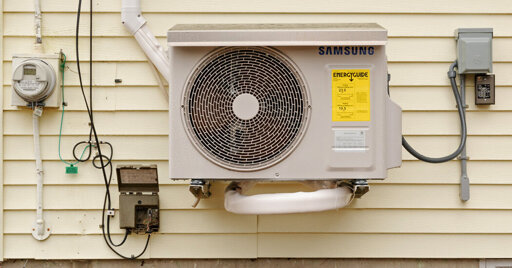- cross-posted to:
- [email protected]
- [email protected]
- cross-posted to:
- [email protected]
- [email protected]
We ripped out our last gas appliances this fall, a gas furnace and gas fireplace log set. We now heat with a Cold Climate rated heat pump, and put in an electric log set. We actually use the fireplace much more now than we did with gas.
We’re very happy with being a fossil fuel free house now.
The big problem is that those billions of dollars in savings would cost billions of dollars in profits for energy companies. As long as Citizens United remains in place, we are unlikely to see any legislation to encourage people to switch.
There are plenty of incentives encouraging people to switch, many coming from the inflation reduction act
My concern is that I expect those incentives to be removed very quickly under the next administration.
Seriously. I expected to be replacing my gas furnace with heat pump in the next few years, but now I have to figure out if I can or should do it asap
Time to kiss all that goodbye
Converted house to a heat pump this year. Never going back.
My wife and I have been eyeing building a house in the coming years since houses in our area are generally overpriced pieces of shit. I’m an electrician by trade and have a lot of friends in complimentary construction fields, so we’ll ultimately be better off building instead of buying and renovating, especially if we space the build out over a few years.
My plan is radiant floors with an electric boiler, heat pumps in every room, electric instahots at every sink/shower location, with an insanely tight building envelope and a massive solar array. Plus, we save $25k out of the gate going without a natural gas connection. I’d probably still pipe in gas lines just in case.
My plan is radiant floors with an electric boiler, heat pumps in every room with an insanely tight building envelope… Plus, we save $25k out of the gate going without a natural gas connection.
The electric boiler is really attractive especially with the option of using A3 refrigerants. We bought an existing house which already had conventional HVAC ducting and very few A2L heat pumps were available this fall for purchase so we had to buy one of the last R-410a units.
, electric instahots at every sink/shower location,
I looked at that route but the energy efficiency is lower compared to other electric only options. Also the maintenance of descaling multiple times a year wasn’t appealing. We went with a tank-based heat pump water heater to replace the existing electric tank water heater. The energy efficiency has been amazing, and the side benefits of extra cooling and de-humidification in the basement where the unit is was nice.
and a massive solar array.
We put in a 17kW array with 10kWh of battery and its been wonderful so far. We haven’t had an electric bill since a month after installation, with this month being the first since then. If your state/locality has true 1:1 Net Metering, the cost of batteries isn’t worth it from a ROI perspective, but we were interested in not only that, but the backup capabilities in the even of an outage.
Good to know about the refrigerant, I haven’t even begun to consider different types of systems.
I didn’t think about the descaling, that’s definitely something to consider. My prime consideration with them was a) save on the extra piping, b) not have to wait for hot water to arrive, wasting water in the process (mountains, it gets a bit nippy up here), c) not have to operate a circ pump. I wouldn’t necessarily mind an electric tank WH, I just thought it’d be nifty having instant hot water in each room and not worrying about the tank running empty.
And yeah since we’re building from scratch, I intend on designing the roof with to accommodate as many panels as necessary (I haven’t even begun to do the load calcs for anything yet. In a perfect world, I’d want the front of the house facing north, leaving the entire south side of the house available for solar without cluttering up the curb appeal. Since we don’t have net metering where I’m at, I also have my eye on a battery system primarily for night operation and outages (they’re frequent up here), and as essentially a whole house UPS.
In a perfect world, I’d want the front of the house facing north, leaving the entire south side of the house available for solar without cluttering up the curb appeal.
This is a good strategy for producing the most electricity, but without net metering, it may not match when you need to use it. Southern facing will give you peak generation at noon. East facing will give you peak production in mid-morning. West facing will give you late afternoon-early evening peak. You can also have parts of your array in all of these directions, if your consumption is fairly even throughout the day.
For HOA reasons, I had to put all 44 panels on the back of my house which faces south-southwest. It was a happy accident that this is also nearly optimized for when we consume the most of our electricity. During the summer, the morning isn’t hot yet so we aren’t running AC much, by high noon we’re generating a really good amount already at the peak of the day heat. By late afternoon-early evening its still very hot and we’re starting to do our cooking and laundry which are larger consumers.
Since we don’t have net metering where I’m at, I also have my eye on a battery system primarily for night operation and outages (they’re frequent up here), and as essentially a whole house UPS.
If you don’t have net metering, make sure you don’t overbuild on your array and waste money. You’ll be producing more electricity than you can use during the daylight hours, and unless you’re buying a mountain of batteries (and batteries are expensive as-is) all that oversupply will go to waste. This is another place where a tank water heater would help you. With the Smart tank water heaters (heat pump or otherwise) you can set them for when they should heat, so you could set it to run while you have excess electricity, essentially a thermal battery.
Do you know if you have “Time of Use” (TOU) options for how you pay for your grid electricity? If so, you could reduce the amount of batteries you need and be able to shave off the most expensive hours (while you run on battery) knowing that your batteries will be close to exhausted most nights, but you’ll recharge them on morning sun.
Our utility up here is pretty much a “you’re lucky we even offer you power” type, so yeah they have nothing for as far as rate incentives or the like. At this point the idea is to operate as if we are off grid, as to only pay the utility access fee (or completely disconnect if possible, I know there are certain legalities with that I need to look into as California tends to frown upon off grid living when utilities are available). Same reason I want a well and have a city water connection as backup. Sewer, trash collection, and Internet would be from local providers.
My current train of thought is, depending on the inverter and charge controller, is to draw direct from solar during the day and batteries at night. Again I haven’t done load calcs, but system sizing depends on max average load during the day while simultaneously charging the batteries. Again a lot of this depends on the house orientation on the lot we get, and how I can balance the design of the house with technical requirements.
I haven’t even gotten into which batteries I’d go for, but I’m leaning towards off the shelf 12/24vdc industrial batteries that I can easily swap as opposed to a monolithic prepackaged system from a company that I may not be able to service myself. My goal is to remain manufacturer agnostic so I don’t run into servicing issues.
Genuine question; how do you prevent freezing pipes in cold climates with instahot taps? AFAIK There’s only so much insulation can do about that (although what i know is pretty little when it comes to plumbing/insulation)
If your pipes inside the house are freezing, then that means the temperature inside the house is below freezing. That means the house heat is off, in which case you have larger problems.
If the house heat is going to be off for an extended time, you should be shutting off the house water supply and opening your tabs to prevent freezing. That’s the same no matter where your water heating happens.
Pretty much what the other guy said. In climates where temps get below freezing, you have to keep your thermostat at 45°F minimum (though most do 55), and pipes are generally run above the insulation in the floor joist. Pipes are run in such a way that they are sloped down towards the stop and waste valve (basically a valve below the frost line that cuts off the water supply into the house and also drains the water inside the pipes when shut off once you open all the faucets). Even lines out of a central water heater need to be considered since unless a circ pump is installed and always running, they’ll freeze the same as cold pipes.
Unless a rebate of some kind happens, you will not get the needed uptick in replacing oil furnaces. I just had this exact conversation this past weekend with my parents. Their house is built back in the 1950s and has an oil furnace. They had replaced it about 8 years ago and refused to get a heat pump due to their current system still being under warranty. Unless it is a free swap, they will never replace it unless the unit dies and is non-repairable.
Part of the problem is the absolutely insane prices that American manufacturers and installers up-charge for heat pumps compared to non-reversible A/C
In all fairness, heat pumps are stupid easy to install, and many of them come as a pre charged kit that you can do yourself. I understand not everyone wants to drill a home in the side of their house, but anyone that is handy can do one themselves in a day.
When we built our home a few years ago, we made sure that everything in the house was electric: no gas water heater, no gas stove, and no gas central heating. Our heat pump works phenomenally well, our electricity bills are very manageable, and we don’t have a gas bill, at all. It’s great, I highly recommend it.
Yeah but it won’t make a select few super rich within these next 4 years, so it won’t happen.
Too dark? Maybe. I don’t see any of this happen in the US.
The only gas appliance left in my house is the stove, but I don’t want to replace it because I hate resistive electric stoves and don’t trust induction ones.
If I could test drive the stove before dropping a couple grand on it that would be great, but I haven’t found a way to do that.
I dipped my toes into induction with a single burner that plugs into the wall. Just be sure to get a large enough one, just assume that the circle they draw on the plate lies by about 2 inches (i.e. the heating element is smaller than the lie they print on the box). I will never go back, thermostat-controlled induction is by far the most superior way to cook. Just set the target temp and you never have to fiddle with knobs no matter how many ingredients you add/remove while cooking.
You must have gotten a better hot plate than I did. Mine doesn’t maintain temperature and burns things consistently due to very slow pulse width modulation.
But it’s great for searing and boiling things.







